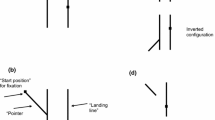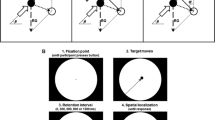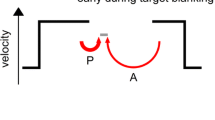Abstract.
It is still a matter of debate whether the control of smooth pursuit eye movements involves an internal drive signal from object motion perception. We measured human target velocity and target position perceptions and compared them with the presumed pursuit control mechanism (model simulations). We presented normal subjects (Ns) and vestibular loss patients (Ps) with visual target motion in space. Concurrently, a visual background was presented, which was kept stationary or was moved with or against the target (five combinations). The motion stimuli consisted of smoothed ramp displacements with different dominant frequencies and peak velocities (0.05, 0.2, 0.8 Hz; 0.2–25.6°/s). Subjects always pursued the target with their eyes. In a first experiment they gave verbal magnitude estimates of perceived target velocity in space and of self-motion in space. The target velocity estimates of both Ns and Ps tended to saturate at 0.8 Hz and with peak velocities >3°/s. Below these ranges the velocity estimates showed a pronounced modulation in relation to the relative target-to-background motion ('background effect'; for example, 'background with'-motion decreased and 'against'-motion increased perceived target velocity). Pronounced only in Ps and not in Ns, there was an additional modulation in relation to the relative head-to-background motion, which co-varied with an illusion of self-motion in space (circular vection, CV) in Ps. In a second experiment, subjects performed retrospective reproduction of perceived target start and end positions with the same stimuli. Perceived end position was essentially veridical in both Ns and Ps (apart from a small constant offset). Reproduced start position showed an almost negligible background effect in Ns. In contrast, it showed a pronounced modulation in Ps, which again was related to CV. The results were compared with simulations of a model that we have recently presented for velocity control of eye pursuit. We found that the main features of target velocity perception (in terms of dynamics and modulation by background) closely correspond to those of the internal drive signal for target pursuit, compatible with the notion of a common source of both the perception and the drive signal. In contrast, the eye pursuit movement is almost free of the background effect. As an explanation, we postulate that the target-to-background component in the target pursuit drive signal largely neutralises the background-to-eye retinal slip signal (optokinetic reflex signal) that feeds into the eye premotor mechanism as a competitor of the target retinal slip signal. An extension of the model allowed us to simulate also the findings of the target position perception. It is assumed to be represented in a perceptual channel that is distinct from the velocity perception, building on an efference copy of the essentially accurate eye position. We hold that other visuomotor behaviour, such as target reaching with the hand, builds mainly on this target position percept and therefore is not contaminated by the background effect in the velocity percept. Generally, the coincidence of an erroneous velocity percept and an almost perfect eye pursuit movement during background motion is discussed as an instructive example of an action-perception dissociation. This dissociation cannot be taken to indicate that the two functions are internally represented in separate brain control systems, but rather reflects the intimate coupling between both functions.
Similar content being viewed by others
Author information
Authors and Affiliations
Additional information
Electronic Publication
Rights and permissions
About this article
Cite this article
Schweigart, .G., Mergner, .T. & Barnes, .G. Object motion perception is shaped by the motor control mechanism of ocular pursuit. Exp Brain Res 148, 350–365 (2003). https://doi.org/10.1007/s00221-002-1306-3
Received:
Accepted:
Issue Date:
DOI: https://doi.org/10.1007/s00221-002-1306-3




